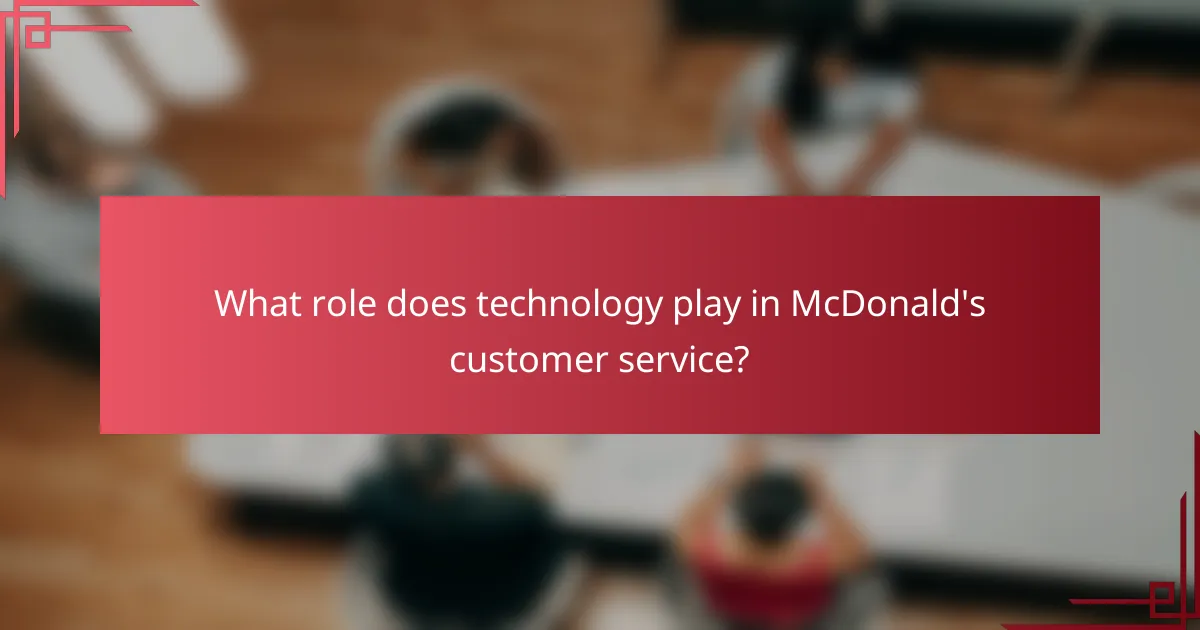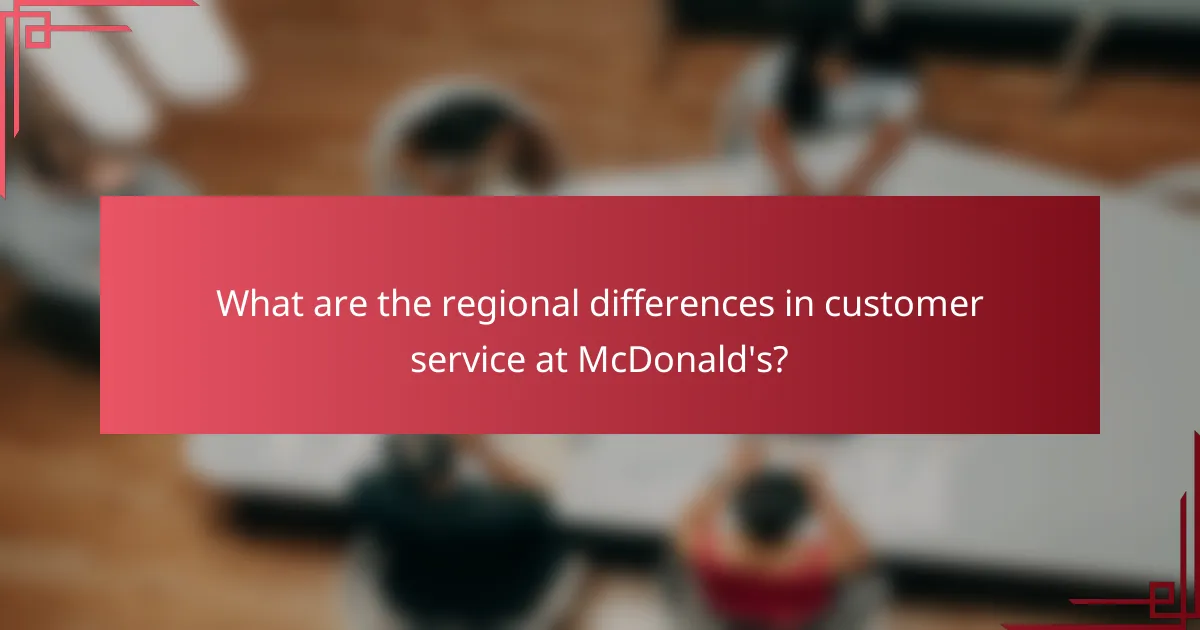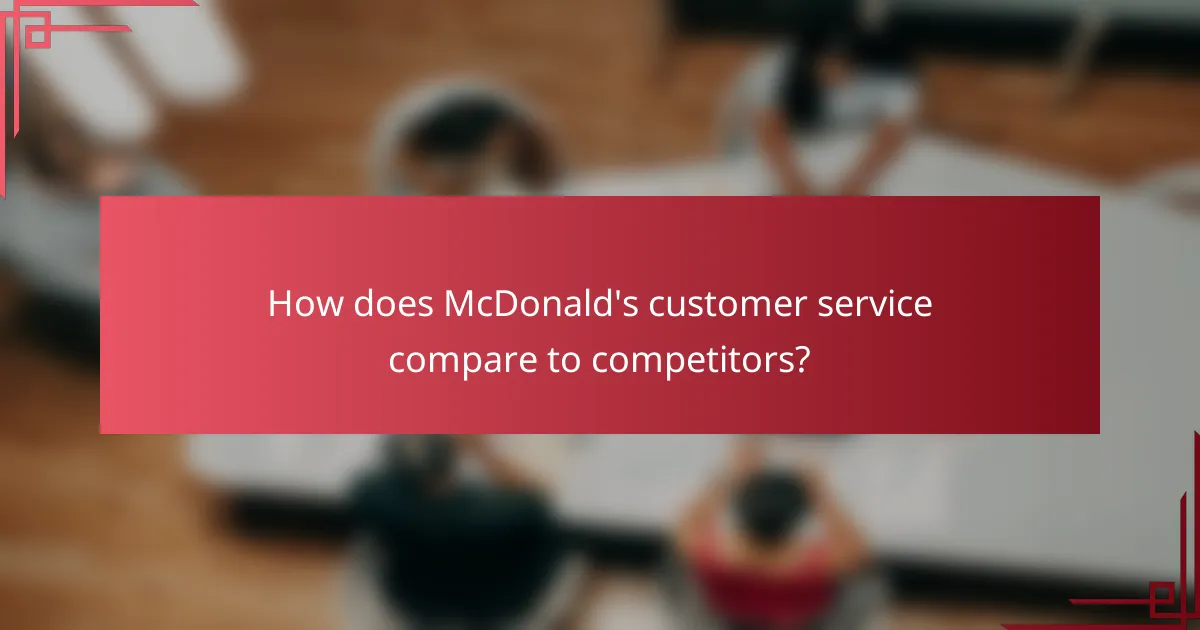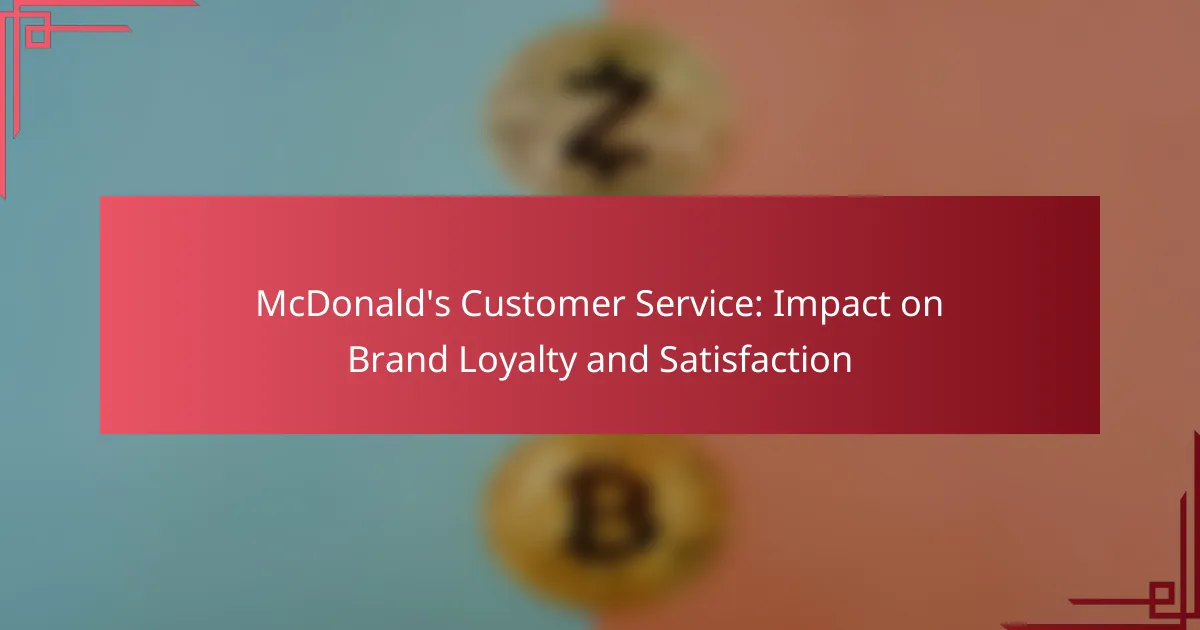McDonald’s customer service plays a pivotal role in shaping brand loyalty and satisfaction among its UK customers. Positive interactions, characterized by quick service, quality food, and friendly staff, foster emotional connections that encourage repeat visits, while negative experiences can deter customers. By actively addressing complaints and prioritizing responsiveness, McDonald’s aims to enhance overall customer experience and loyalty.

How does McDonald’s customer service affect brand loyalty in the UK?
McDonald’s customer service significantly influences brand loyalty in the UK by shaping customers’ perceptions and experiences. Positive interactions can lead to repeat visits and stronger emotional connections, while negative experiences may drive customers away.
Positive customer experiences enhance loyalty
When customers receive friendly and efficient service at McDonald’s, they are more likely to return. Positive experiences, such as quick order fulfillment and helpful staff, create a sense of satisfaction that fosters loyalty. For instance, customers who feel valued and appreciated are likely to recommend McDonald’s to friends and family.
Moreover, loyalty programs and promotions that reward frequent visits can further enhance customer retention. Engaging with customers through personalized offers or feedback requests also strengthens their connection to the brand.
Negative interactions lead to customer churn
Negative customer service experiences can quickly result in customer churn, as dissatisfied patrons may choose to dine elsewhere. Issues such as long wait times, incorrect orders, or unhelpful staff can tarnish the brand’s reputation and lead to lost sales. In the competitive fast-food market, even a single bad experience can deter customers from returning.
To mitigate the risk of churn, McDonald’s should prioritize training staff to handle complaints effectively and ensure consistent service quality. Regularly monitoring customer feedback can help identify problem areas and improve overall service standards.

What are the key factors influencing customer satisfaction at McDonald’s?
Key factors influencing customer satisfaction at McDonald’s include speed of service, quality of food, and staff friendliness. Each of these elements plays a crucial role in shaping the overall customer experience and can significantly impact brand loyalty.
Speed of service
Speed of service is critical at McDonald’s, where customers expect quick meal preparation and delivery. Typically, drive-thru orders are completed in under five minutes, while in-store orders should ideally take less than ten minutes during peak hours.
To enhance satisfaction, McDonald’s employs efficient kitchen workflows and technology, such as order kiosks, to streamline the process. Customers appreciate quick service, especially during busy times, which can lead to repeat visits.
Quality of food
The quality of food at McDonald’s directly affects customer satisfaction and loyalty. Customers expect their meals to be fresh, tasty, and consistent across locations. Regular quality checks and adherence to food safety standards are essential to maintain this expectation.
McDonald’s has made efforts to improve food quality by sourcing ingredients responsibly and offering healthier options. Customers are increasingly looking for transparency in food sourcing, which can influence their perception of the brand.
Staff friendliness
Staff friendliness is a vital aspect of the customer experience at McDonald’s. Friendly and attentive service can enhance the overall dining experience, making customers feel valued and welcomed. Employees are trained to engage positively with customers, which can lead to higher satisfaction rates.
Positive interactions with staff can encourage customers to return, while negative experiences can deter them. McDonald’s often emphasizes customer service training to ensure employees understand the importance of a friendly demeanor in fostering brand loyalty.

How does McDonald’s handle customer complaints?
McDonald’s addresses customer complaints through a structured approach that emphasizes responsiveness and resolution. They utilize various channels to ensure that customer feedback is heard and acted upon promptly.
Dedicated customer service channels
McDonald’s provides multiple channels for customers to voice their complaints, including a dedicated customer service hotline, online feedback forms, and social media platforms. This multi-channel approach allows customers to choose the method that is most convenient for them.
Additionally, the McDonald’s app includes a feedback feature, enabling users to report issues directly through their mobile devices. This accessibility is crucial for enhancing customer satisfaction and loyalty.
Response time and resolution effectiveness
The response time for customer complaints at McDonald’s typically ranges from a few hours to a couple of days, depending on the channel used. Quick responses are essential for maintaining customer trust and satisfaction.
McDonald’s aims for a high resolution effectiveness rate, often addressing complaints within a single interaction. However, complex issues may require follow-up, which can extend the resolution time. Customers are encouraged to provide clear details to facilitate faster resolutions.

What role does technology play in McDonald’s customer service?
Technology significantly enhances McDonald’s customer service by streamlining the ordering process and improving overall customer satisfaction. Through various digital platforms, customers can enjoy a more efficient experience, leading to increased brand loyalty.
Mobile app for order tracking
The McDonald’s mobile app allows customers to track their orders in real-time, providing transparency and reducing wait times. Users can place orders ahead of time and receive notifications when their food is ready, which enhances convenience.
Additionally, the app often features exclusive deals and promotions, encouraging users to engage more frequently. This not only boosts customer satisfaction but also fosters loyalty as customers feel valued through personalized offers.
Self-service kiosks
Self-service kiosks at McDonald’s enable customers to customize their orders without the pressure of a busy counter. These kiosks are user-friendly and typically feature large touchscreens that simplify the ordering process.
By using kiosks, customers can avoid long lines and have more control over their meal choices, which can lead to a more satisfying dining experience. Furthermore, these kiosks often reduce the workload on staff, allowing them to focus on food preparation and customer service.

How does McDonald’s train its staff for customer service excellence?
McDonald’s trains its staff through structured programs designed to enhance customer service skills and ensure a consistent experience across locations. This training focuses on effective communication, problem-solving, and operational efficiency to foster brand loyalty and customer satisfaction.
Comprehensive training programs
McDonald’s implements comprehensive training programs that cover various aspects of customer service. New employees typically undergo an orientation that includes hands-on training in areas such as order taking, food preparation, and customer interaction. This initial training is crucial for instilling the brand’s service standards from day one.
Additionally, McDonald’s utilizes e-learning modules and in-person workshops to reinforce skills and introduce new service protocols. These programs are designed to be engaging and practical, ensuring that staff can apply what they learn directly to their daily tasks.
Regular performance evaluations
Regular performance evaluations are a key component of McDonald’s approach to maintaining high customer service standards. Managers conduct assessments to provide feedback on staff performance, focusing on areas such as speed, accuracy, and customer engagement. This feedback loop helps employees understand their strengths and areas for improvement.
Moreover, these evaluations often include customer feedback, allowing staff to see how their service impacts customer satisfaction. Recognizing and rewarding high performers can motivate staff to maintain excellence in service delivery, further enhancing brand loyalty among customers.

What are the regional differences in customer service at McDonald’s?
Customer service at McDonald’s varies significantly by region, influenced by local expectations, cultural norms, and operational practices. These differences can impact customer satisfaction and brand loyalty across various markets.
Variations in service standards across the UK
In the UK, McDonald’s service standards are generally high, with a focus on speed and efficiency. Customers often expect their orders to be processed within a few minutes, and staff are trained to maintain a friendly demeanor while managing busy periods. However, regional variations exist, with urban locations typically experiencing faster service compared to rural areas.
Additionally, customer feedback mechanisms, such as surveys, are frequently utilized to assess service quality. This feedback helps McDonald’s adapt its service strategies to meet local expectations, ensuring that customers feel valued and heard.
Local cultural influences on service
Cultural influences play a crucial role in shaping customer service at McDonald’s. In the UK, politeness and a friendly approach are highly valued, which is reflected in staff training programs. Employees are encouraged to engage with customers, often using phrases like “please” and “thank you” to enhance the dining experience.
Moreover, local events and holidays can affect service styles. For instance, during major sporting events, McDonald’s may see an increase in group orders, prompting staff to adapt their service approach to accommodate larger parties efficiently. Understanding these cultural nuances is essential for maintaining high levels of customer satisfaction and loyalty.

How does McDonald’s customer service compare to competitors?
McDonald’s customer service generally ranks favorably against its competitors, particularly in speed and consistency. While each fast-food chain has its strengths, McDonald’s focus on efficiency and customer satisfaction often leads to higher loyalty and repeat business.
Benchmarking against Burger King
When comparing McDonald’s customer service to Burger King, McDonald’s typically excels in order accuracy and speed of service. Customers often report shorter wait times at McDonald’s, which can be crucial during peak hours. Burger King, while offering a unique menu, sometimes struggles with consistency in service quality across locations.
Additionally, McDonald’s has invested heavily in technology, such as self-service kiosks and mobile ordering, enhancing the overall customer experience. This technological edge can lead to increased customer satisfaction compared to Burger King’s more traditional service model.
Comparative analysis with KFC
In contrast to KFC, McDonald’s customer service is often perceived as more efficient, particularly in drive-thru operations. KFC’s focus on freshly prepared food can lead to longer wait times, which may affect customer satisfaction during busy periods. McDonald’s streamlined processes help maintain a quicker turnover, appealing to customers seeking fast service.
However, KFC often emphasizes personalized service and a more relaxed dining atmosphere, which can enhance customer loyalty in certain demographics. While McDonald’s prioritizes speed, KFC’s approach may resonate better with customers looking for a more engaging dining experience.

What emerging trends are shaping McDonald’s customer service?
Emerging trends in McDonald’s customer service focus on technology integration, personalization, and sustainability. These trends aim to enhance customer experiences and foster brand loyalty by meeting evolving consumer expectations.
Technology Integration
McDonald’s is increasingly adopting technology to streamline customer service. Innovations such as self-service kiosks and mobile ordering apps allow for faster service and reduced wait times, enhancing overall customer satisfaction.
These technological advancements not only improve efficiency but also provide customers with greater control over their orders. For instance, customers can customize their meals directly through kiosks, ensuring their preferences are met without miscommunication.
Personalization
Personalization is becoming a key focus in McDonald’s customer service strategy. By leveraging data analytics, McDonald’s can tailor promotions and menu suggestions based on individual customer preferences and purchasing history.
This approach not only increases customer engagement but also drives repeat visits. For example, targeted offers through the McDonald’s app can encourage customers to try new items or return for their favorites, enhancing brand loyalty.
Sustainability Initiatives
Sustainability is increasingly influencing customer service at McDonald’s. The company is committed to reducing its environmental impact, which resonates with eco-conscious consumers.
Efforts such as using biodegradable packaging and sourcing ingredients responsibly are becoming integral to the customer experience. These initiatives not only appeal to customers’ values but also enhance the brand’s reputation in a competitive market.
